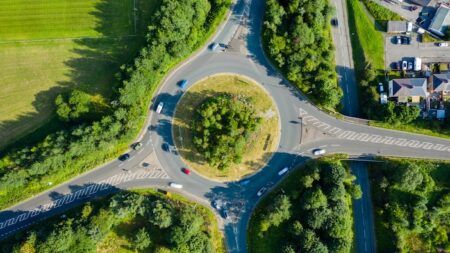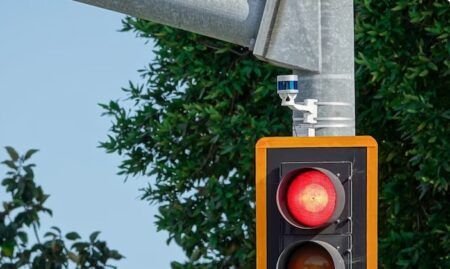Connected Signals, the Oregon-based V2I startup, has revealed details of its patent application for a groundbreaking new system which is capturing signal phase and timing information right across Manhattan, New York, without any direct input from NYCDOT.
Following our report on the new system in the February/March edition of Traffic Technology International magazine, Matt Ginsberg, founder and CEO of Connected Signals, has revealed exclusively to Traffic Technology Today exactly how his company has managed to establish the timings of nearly every signal on Manhattan.
“It’s actually incredibly simple. There are publicly accessible webcams [example screengrab above] scattered around New York City and they can see traffic lights,” says Ginsberg (below). “We have developed software that looks at those webcams and figures out what the traffic signals are doing. So that gives us probably 50 intersections in New York City. Then we just propagate out from there.”
The fact that New York City’s signals are meticulously timed to create ‘green waves’ for traffic traveling up or downtown, and that this wave is not interrupted by priority for public transit or emergency vehicles, means the process of propagation works better than it might in some other cities.
“We know how the timing works, because we have gone to New York and measured it,” says Ginsberg. “We’ve developed a tool that you just drive around or walk around with and it says, ‘What color is the light you are pointed at? Push a button when it changes’. So, we know exactly what the intended speeds are on the streets and that lets us move from one light to the next, to the next, to the next… Eventually our waves of propagation bump into each other and in general they match up, but if they don’t, we can go to New York and figure out what that means and make corresponding adjustments.”
The ultimate aim is that the data will be used in Connected Signals’ EnLighten app (above) that informs drivers whether they will safely make the next green light up ahead, or how long a light will remain red. The interface has been designed with safety as one of its primary aims. “We work incredibly hard to make sure everything we do is safe – and we look carefully at the interfaces to make sure they can’t be dangerous,” says Ginsberg. “We’re in the middle of a study with one of the national US labs to evaluate the driving impact. And very preliminary findings show that people with our app approach intersections more slowly than people without it, which is what you care about. If you can slow people down, people will have fewer accidents.”
Real-time information
The New York system is being built to react in real time to any changes in signal timing -assessing latency on the webcams was done in the early stages. “We went to New York and figured out the latency of those webcams,” says Ginsberg, “which actually just involved just me standing on an intersection and raising and lowering my hand and telling people when I was doing it!”
Ginsberg is now confident that the 50 intersections monitored via webcam will be sufficient to propagate out form, and cover 1,000 intersections with the EnLighten app in real time. The system has not gone live yet as Ginsberg wants to ensure it works well, with as much rigorous testing as possible.
Connected Signals is already offering its services in a number of cities across the US and beyond, including Las Vegas, Portland, Salt Lake City, San Jose, Montreal, Melbourne and Chirstchurch, with excellent feedback from users and road authorities alike. But in all these cases the signal data is being gathered via a direct data feed from traffic managers. The system in New York is the first time signal-timings are being established without any such direct data feed.
“I told the New York guys that we were doing it, and I told them that I wasn’t going to tell them how, but it was legal, and they figured, ‘OK’,” says Ginsberg. “In the past we have viewed municipal data acquisition as a sales problem and we have brought sales people to bear. But what we have started doing in the last 12 months is looking at this as a technical problem, where we can bring cities online through technical measures, as well as by just convincing them.”
Although Ginsberg talks in terms of ‘sales’, his services are offered completely free to city authorities and the app is free to download. “We commit to our city partners that we will never charge for this,” he says. “Automotive OEMs and the manufactures of autonomous vehicles are our potential customers. Having access to a confirming data stream is going to be very important for them.” Indeed, the information is already available to some BMW drivers through a dashboard interface (above).
Ginsberg is so happy with the new system in New York that he hopes it will be of use in bringing other cities ‘online’ in the future. He does not rule out the possibility of paying the owners of private buildings near intersections to install webcams on their building exteriors for the sole purpose of monitoring signal timings. While the EnLighten app is currently Infrastructure-to-Vehicle only, Ginsberg also hints at work he is doing to enable Vehicle-to-Infrastructure communication. We will bring you details in the coming weeks.




